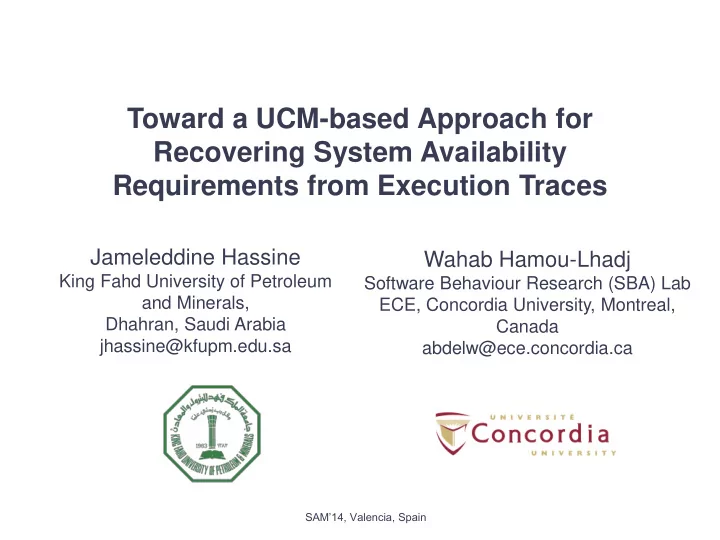

Toward a UCM-based Approach for Recovering System Availability Requirements from Execution Traces Jameleddine Hassine Wahab Hamou-Lhadj King Fahd University of Petroleum Software Behaviour Research (SBA) Lab and Minerals, ECE, Concordia University, Montreal, Dhahran, Saudi Arabia Canada jhassine@kfupm.edu.sa abdelw@ece.concordia.ca SAM’14, Valencia, Spain
Goal and Applications Goal: To provide an approach based on UCM, a high-level visual requirement description language, for recovering system availability features from execution logs. Applications: Verification of system implementation w.r.t. availability requirements Understanding, analyzing, and system debugging Simulation of system scenarios Documentation and knowledge sharing 2
UCM: Use Case Maps Part of the ITU-T User Requirements Notation (URN) standard. A high-level visual scenario-based modeling language. Used to capture and integrate functional requirements in terms of causal scenarios. Static and behaviour of the system are shown in one diagram. Provides the stakeholders with guidance and reasoning about the system-wide architecture and behaviour. Good tool support: JUCMNav. 3
Example of a UCM 4
Approach 5
Timestamp Process ID Facility Severity Description Approach: Log Generation 6
Approach: Log Generation 7
Approach: Log Customization 8
Approach: Phase Extraction 9
Approach: Phase Extraction 10
Log entries from different components are placed in separate phases Log entries describing different features' events/errors are placed into separate phases. Log entries relative to user actions are separated from system response log. Etc. Approach: Phase Extraction 11
Approach: Mapping to UCM 12
Each log entry is mapped to one responsibility. An execution phase with more than one responsibility is described using a plugin enclosed within a static stub. A phase, part of the exception path, having a single responsibility should be enclosed within a static stub. Sequential stubs bound to the same component and belonging to one path (regular or exception), may be refactored into a static stub. Component related information such as the redundancy protocol, the redundancy group, etc., are mapped to component metadata attributes. In case two log entries have the same timestamp, their corresponding responsibilities should be enclosed within an AND-Fork and an AND- Join. Approach: Mapping to UCM 13
Approach: Mapping to UCM 14
Preliminary Evaluation Target System: Hot Standby Router Protocol (HSRP) A Cisco proprietary protocol that provides network redundancy for IP networks. By sharing an IP address and a MAC address, two or more routers can act as a single virtual router, known as an HSRP group or a standby group. The active router, elected from the group, is responsible for forwarding the packets that hosts send to the virtual router. If the active router fails, the standby router takes over as the active router. If the standby router fails or becomes the active router, then another router is elected as the standby router. 15
Testbed: Network topology Two FastEthernet Interfaces: F0/0 and F0/1 The testbed was built using the Graphical Network Simulator 3 (GNS3) simulation software. GNS3 allows to emulate complex networks, by combining actual devices and virtual devices together. Logs can be collected from Cisco IOS routers through console logging (default mode), syslog server logging (use of external syslog servers for log storage )… 16
Sample logs for Router R1 After the log customization and phase extraction steps 17
18
Combining R1 and R2 Logs 19
20
Conclusion and Future Directions We proposed a UCM-based approach for recovering availability requirements from log/traces The approach relies on multiple processing of log information including the extraction of execution phases Future Work: Automation: investigate how the identification of execution phases can be automated (identify availability patterns, use of heuristics, etc.) Scalability: apply the approach to more complex systems (with larger system logs) Generalization: generalize the approach to other HA management systems (e.g., AMF from SAForum) Usability: work with analysts to assess the usability and utility of the approach in practice 21
Thank you. 22
Recommend
More recommend